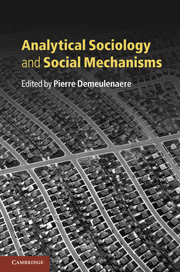Book contents
- Frontmatter
- Contents
- List of figures
- List of tables
- List of contributors
- Introduction
- Part I Action and mechanisms
- 1 Ordinary rationality: the core of analytical sociology
- 2 Indeterminacy of emotional mechanisms
- 3 A naturalistic ontology for mechanistic explanations in the social sciences
- 4 Conversation as mechanism: emergence in creative groups
- Part II Mechanisms and causality
- Part III Approaches to mechanisms
- Index
- References
2 - Indeterminacy of emotional mechanisms
Published online by Cambridge University Press: 05 June 2012
- Frontmatter
- Contents
- List of figures
- List of tables
- List of contributors
- Introduction
- Part I Action and mechanisms
- 1 Ordinary rationality: the core of analytical sociology
- 2 Indeterminacy of emotional mechanisms
- 3 A naturalistic ontology for mechanistic explanations in the social sciences
- 4 Conversation as mechanism: emergence in creative groups
- Part II Mechanisms and causality
- Part III Approaches to mechanisms
- Index
- References
Summary
Introduction
Emotion-based actions involve causal mechanisms in three steps (see Figure 2.1). First, there is a belief (sometimes a perception) that triggers an emotion. Second, the emotion triggers an action tendency. Third, the action tendency may be strengthened, weakened or blocked by other motivational forces. I discuss these steps in the remaining sections of this chapter. The final section offers a brief conclusion.
Let me first explain how I use the term “mechanism.” As in my recent work (Elster 1999: a, ch. I; Elster 2007: a, ch. 2) I define mechanisms as frequently occurring and easily recognizable causal patterns that are triggered under generally unknown conditions or with indeterminate consequences. In my conception of mechanisms, they are defined by the feature of indeterminacy. In what I call type A mechanisms, the indeterminacy concerns which of several possible mechanisms will be triggered, e.g. sour grapes versus forbidden fruits. In type B mechanisms, it concerns the net effect of several opposite mechanisms that are triggered simultaneously, such as the income effect and the substitution effect.
I shall not here try to argue for the usefulness of this conception, but simply point to the main implication for my purposes here, which is that the relations between belief and emotion and between emotion and action are not one–one, but one–many or many–one. The examples given later will clarify this idea.
- Type
- Chapter
- Information
- Analytical Sociology and Social Mechanisms , pp. 50 - 63Publisher: Cambridge University PressPrint publication year: 2011
References
- 14
- Cited by



